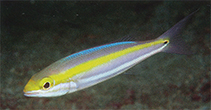| Family: |
Nemipteridae (Threadfin breams, Whiptail breams) |
| Max. size: |
30 cm TL (male/unsexed) |
| Environment: |
reef-associated; marine; depth range 10 - 70 m |
| Distribution: |
Western Pacific: northeastern Australia, southern Papua New Guinea, Solomon Islands and the Philippines. This species has been previously confused with Pentapodus setosus by most authors. |
| Diagnosis: |
Dorsal spines (total): 10-10; Dorsal soft rays (total): 9-9; Anal spines: 3-3; Anal soft rays: 7-7. Head scales reaching forward to or almost to level of posterior nostrils. Suborbital naked. Lower limb of preopercle naked. Pelvic fins short, not reaching to level of anus. Upper lobe of caudal fin produced into a very long trailing yellowish-brown filament. Axillary scale present. Color: Upper body pale brownish, lower whitish. Presence of three bluish stripes across snout, first joining eyes behind nostrils, second in front of nostrils, third from eye to tip of snout. A yellow stripe from behind eye to upper base of pectoral fin. A yellow stripe from middle of upper lip, beneath eye to below pectoral fin. |
| Biology: |
Found near reefs. Juveniles in rubble areas (Ref. 9710). Solitary or in small groups (Ref. 90102). Feeds on small fishes, crustaceans and polychaetes (Ref. 9785). |
| IUCN Red List Status: |
Least Concern (LC); Date assessed: 16 July 2020 Ref. (130435)
|
| Threat to humans: |
harmless |
Source and more info: www.fishbase.org. For personal, classroom, and other internal use only. Not for publication.
